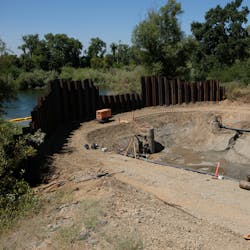In the spring of 2017, an iconic piece of American folklore was on course to repeat itself in the foothills of the Sierra Nevada. Following weeks of heavy downpours, the Oroville Dam in Butte County, Northern California, was under increasing strain — and when its emergency spillway was forced to close down after struggling to cope with the diverted flow, 188,000 local residents had to be evacuated as a precautionary measure. Fortunately, despite severe damage to the spillway, both it and the dam held up until drier conditions prevailed and proper repairs could commence.
But by the summer, rather like they had done almost 170 years earlier, hopeful prospectors were flocking to the Feather and Yuba rivers to pan for the flakes of gold that had drifted downstream as a result of the devastation to the mountain below the spillway. However, just like many of those attracted to the state during the original Gold Rush, these modern-day treasure hunters would inevitably leave with their fantasies of unparalleled riches unfulfilled.
Dredge Report
As the town's name suggests, a select few did strike it lucky. Dredging soon became the favored method of finding gold and, as a result, an estimated 165 million tons of river rock littered the area after commercial mining had ceased. Much of this would be used to build the aforementioned dam after blueprints were drawn up in the late 1950s, but the environmental damage in what would eventually become the Oroville Wildlife Area (OWA) was still plain to see. This was usually most noticeable following the wet season when the river had overflowed into the almost 12,000-acre floodplain on its eastern bank; once the water eventually receded back behind the berm, a series of isolated ponds would remain between the mounds of tailings, in which native salmon and other fish would become trapped.
So, in an attempt to rectify the situation, the $16.7 million Oroville Wildlife Area Flood Stage Reduction Project was set up in 2016 to decrease flood stages within the main channel, reduce post-flood maintenance and repairs, and restore riparian and fish habitats. A cooperation between the Department of Water Resources, the Department of Fish and Wildlife, and the Sutter Butte Flood Control Agency, the scheme aimed to augment the existing system of inflow and outflow weirs to safely divert floodwaters from the main channel and into the OWA.
After the Deluge
In terms of addressing fish-stranding risks, a series of measures were introduced, including construction of a 3,000-foot berm to prevent their passage into one particularly hazardous area, and improvements to approximately 7,500 feet of existing channels within the OWA to enhance access in and out of the area. Along with the removal of the high berms along either side, these channels needed grading to connect them with the isolated ponds and convey floodwater to and from the main channel.
This was achieved with the cutting of additional notch connections through an existing berm to reconnect the river with its historic floodplain. This would create 150 acres or so of 2-year shallow floodplain salmonid habitat, relying on a series of box culverts with sluice gates to control flow, and it was here that an echo of that impressive Gold Rush era engineering could be seen.
"We needed durable and reliable pumps that could work 24/7 moving water from the construction site," said Patrick LaZansky, specialty sales representative at Herc Pro Solutions, the equipment rental company that supplied the dewatering design and Tsurumi units for the project. "It was a tough job as the pumps needed to transfer water in an abrasive environment."
"The pumps' top discharge and slim design allowed the contractors to get away with just drilling a 12-inch well casing," explained LaZansky. "Then they were able to quickly remove both ground and surface water, keeping the area sufficiently dry to begin concrete pouring. The water was boosted to a settling basin about 1,000 feet away, which then percolated back into the river."
The construction part of the project was completed on schedule in the fall of 2019, and so far appears to have been a success, both in terms of safeguarding fish stocks as well as reducing flood risks further downstream.
"A lot of damage was done to this area 170 years ago, so it's great to be able to begin making amends," LaZansky concluded. "This new channel is environmentally significant because it contributes to salmon runs in the region, making it possible for fish to return to the river and ocean, no longer interrupting their spawning cycles." SW
References
1. Putnam, J. "Oroville, California’s City of Gold," My Gold Rush Tales (website), July 5, 2011. See: http://mygoldrushtales.com/oroville-california%e2%80%99s-city-of-gold/ (last accessed April 14, 2021)
Published in Stormwater, May 2021.
About the Author

Jeff Davis
Jeff Davis is a regional sales manager with Tsurumi Pump. He has 23 years of sales management and training experience in the pump industry. He earned his B.A. degree in psychology at Carson Newman University, and has served in the U.S. Navy as an aviation electronics technician.







